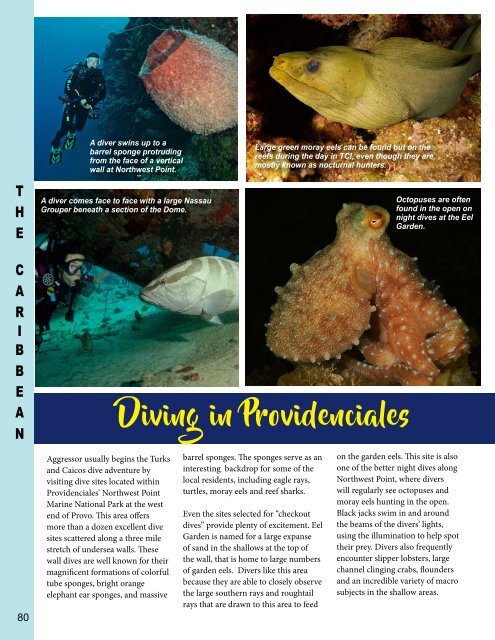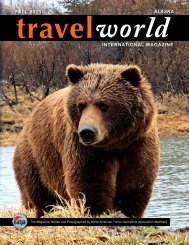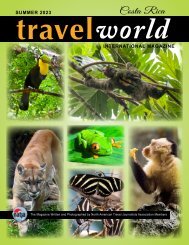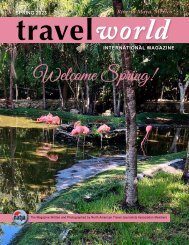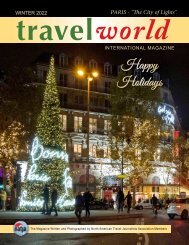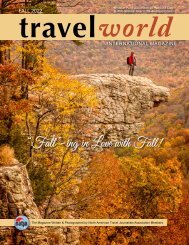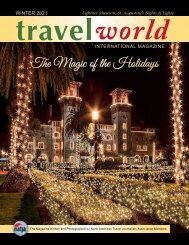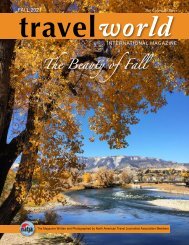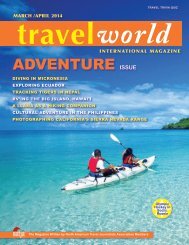TravelWorld International Magazine, Spring 2022 - Spring into Travel
The magazine written and photographed by members of the North American Travel Journalists Association.
The magazine written and photographed by members of the North American Travel Journalists Association.
Create successful ePaper yourself
Turn your PDF publications into a flip-book with our unique Google optimized e-Paper software.
N<br />
O<br />
T<br />
RH<br />
TE<br />
H<br />
C<br />
A<br />
A<br />
R<br />
I<br />
B<br />
M<br />
EB<br />
RE<br />
A<br />
I<br />
N<br />
C<br />
A<br />
80<br />
A diver swins up to a<br />
barrel sponge protruding<br />
from the face of a vertical<br />
wall at Northwest Point.<br />
A diver comes face to face with a large Nassau<br />
Grouper beneath a section of the Dome.<br />
Aggressor usually begins the Turks<br />
and Caicos dive adventure by<br />
visiting dive sites located within<br />
Providenciales’ Northwest Point<br />
Marine National Park at the west<br />
end of Provo. This area offers<br />
more than a dozen excellent dive<br />
sites scattered along a three mile<br />
stretch of undersea walls. These<br />
wall dives are well known for their<br />
magnificent formations of colorful<br />
tube sponges, bright orange<br />
elephant ear sponges, and massive<br />
barrel sponges. The sponges serve as an<br />
interesting backdrop for some of the<br />
local residents, including eagle rays,<br />
turtles, moray eels and reef sharks.<br />
Even the sites selected for “checkout<br />
dives” provide plenty of excitement. Eel<br />
Garden is named for a large expanse<br />
of sand in the shallows at the top of<br />
the wall, that is home to large numbers<br />
of garden eels. Divers like this area<br />
because they are able to closely observe<br />
the large southern rays and roughtail<br />
rays that are drawn to this area to feed<br />
Large green moray eels can be found out on the<br />
reefs during the day in TCI, even though they are<br />
mostly known as nocturnal hunters.<br />
Diving in Providenciales<br />
Octopuses are often<br />
found in the open on<br />
night dives at the Eel<br />
Garden.<br />
on the garden eels. This site is also<br />
one of the better night dives along<br />
Northwest Point, where divers<br />
will regularly see octopuses and<br />
moray eels hunting in the open.<br />
Black jacks swim in and around<br />
the beams of the divers’ lights,<br />
using the illumination to help spot<br />
their prey. Divers also frequently<br />
encounter slipper lobsters, large<br />
channel clinging crabs, flounders<br />
and an incredible variety of macro<br />
subjects in the shallow areas.<br />
ne of the most unique dive<br />
sites at Northwest Point is<br />
called the “ThunderDome.”<br />
How often do you get to<br />
dive a site that got its name<br />
because it used to be part of the<br />
set for a television game show. The main<br />
feature of this site is the “Dome,” which<br />
was originally constructed as the focal<br />
point of a French television game show<br />
called “Le Tresor de Pago Pago” or The<br />
Treasure of Pago Pago. This show was<br />
filmed in the Turks and Caicos Islands<br />
in 1992 and was Broadcast on French<br />
TV in 1993 and 1994. On the TV show,<br />
contestants had to free dive (on a single<br />
breath of air) through a rectangular<br />
opening in the top of the dome and<br />
gather pearls that were “spit out” <strong>into</strong><br />
the water by a man-made, metal stove<br />
pipe sponge that sat inside the dome.<br />
The base of the structure sat on a flat<br />
sandy bottom at a depth of 30 feet, and<br />
the top was at a depth of 15 feet. During<br />
the course of each contest segment, the<br />
contestants would grab as many pearls<br />
as possible on a single breath of air<br />
and would receive 250 Francs for each<br />
pearl. Fortunately, no-one died during<br />
the show, but the show was canceled<br />
after several contestants suffered air<br />
embolisms or similar “dive-related”<br />
medical issues, and had to receive<br />
treatment at the local recompression<br />
chamber to recover.<br />
Although the dome collapsed during<br />
hurricane Francis in 2004, the large<br />
pieces of the dome scattered about the<br />
bottom provide shelter to an incredible<br />
variety of marine life. Divers will<br />
encounter schools of grunt, goatfish,<br />
schoolmasters and snapper that take<br />
refuge beneath the sections. There is a<br />
plethora of friendly angelfish, Nassau<br />
grouper, squirrelfish, moray eels, and<br />
other marine animals wandering in<br />
and out of the protected areas of the<br />
Dome, which seem unconcerned by<br />
the close proximity of the divers, thus<br />
allowing endless opportunities for<br />
photos and video.<br />
Schools of<br />
grunts and<br />
Schoolmasters<br />
can be always<br />
be found taking<br />
refuge under<br />
the scattered<br />
sections of the<br />
Thunderdome.<br />
A Caribbean reef shark<br />
patrols the wall at<br />
Highway to Heaven.<br />
This image of the Thunderdome was taken in<br />
1999 prior to the structure being collapsed by<br />
hurricane Francis in 2004.<br />
T<br />
U<br />
RT<br />
H<br />
K<br />
E<br />
S<br />
C<br />
A<br />
&<br />
R<br />
I<br />
CB<br />
B<br />
A<br />
E<br />
AI<br />
C<br />
N<br />
O<br />
S<br />
81


